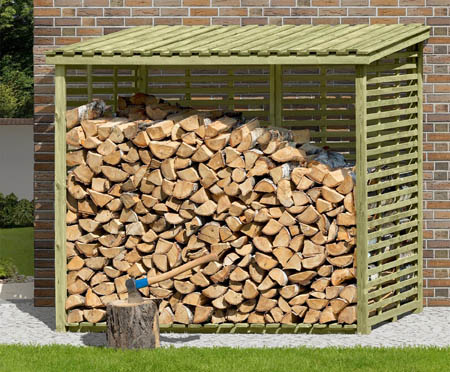 Whether you run your fireplace with hardwood (highly recommended) or burn softwood (flying sparks!), the firewood must be dry. A weatherproof shed is ideal and much easier to build, than you think!
Whether you run your fireplace with hardwood (highly recommended) or burn softwood (flying sparks!), the firewood must be dry. A weatherproof shed is ideal and much easier to build, than you think!
Our grandparents' wooden shed looked just like ours: a solid batten construction, with a rainproof roof and stormproof. The scales used to be bigger, because at that time much more wood was burned than in the age of central heating. For the amounts of wood, that you need nowadays for heating or for a cozy fireplace, our firewood shed with its around four cubic meters of storage space is sufficient. But even if it should be bigger, our construction offers all possibilities: He's designed that way, that the width can be varied – and of course the height, if it is to be stacked high. With its depth of 80 cm (at the roof 105 cm) the shed takes up very little space. Which also makes it the ideal place for garden tools or furniture.
To the building material: The stud frame is off 4 x 6 cm thick spruce strips built, the floor off 10 x 1,8 cm thick spruce boards and the roof made of rough-tongue planks of about the same thickness. The outer covering of the house with impregnated fence slats is extremely decorative, which are available in almost all timber shops and garden centers.
You don't need a lot of tools to build the wooden shed – really just a hammer and a sharp foxtail. Of course, it's easier to use a hand-held circular saw. a cap- and miter saw is especially useful then, if the diagonal strips are to be mitred. We also used a cordless drill, a wrench for the 6 mm carriage bolts and a hand tacker for the roof foil. That's all.
When the wooden shed is set up at the house, you should secure it with wall plugs and screws. Shouldn't it be connected to the house, you have to screw diagonal bracing to the rear wall. You can use galvanized steel perforated tape or a simple slat for this.
If you want to put a green roof on the shed, should you – before covering – drill a few holes next to each other in the front bar, directly above the level of the roof slab. Then excess rainwater can run off.
Since the fence slats are already impregnated, the protection of the wood is limited to glazing the roof end boards. You can also match the visible front uprights to the brown of the hunter's fence slats.
No wood protection is required on the inside, because the roof overhang keeps moisture away